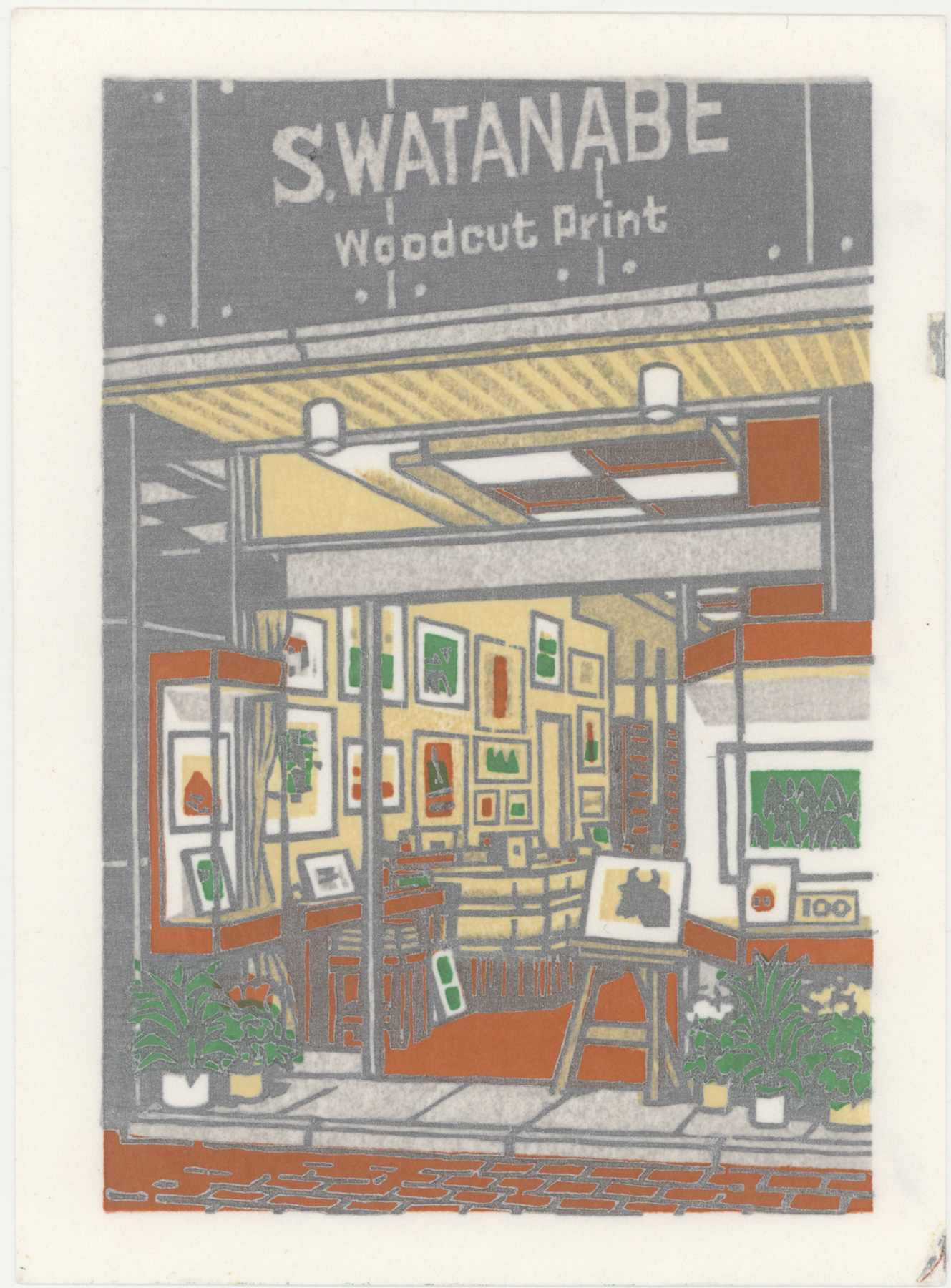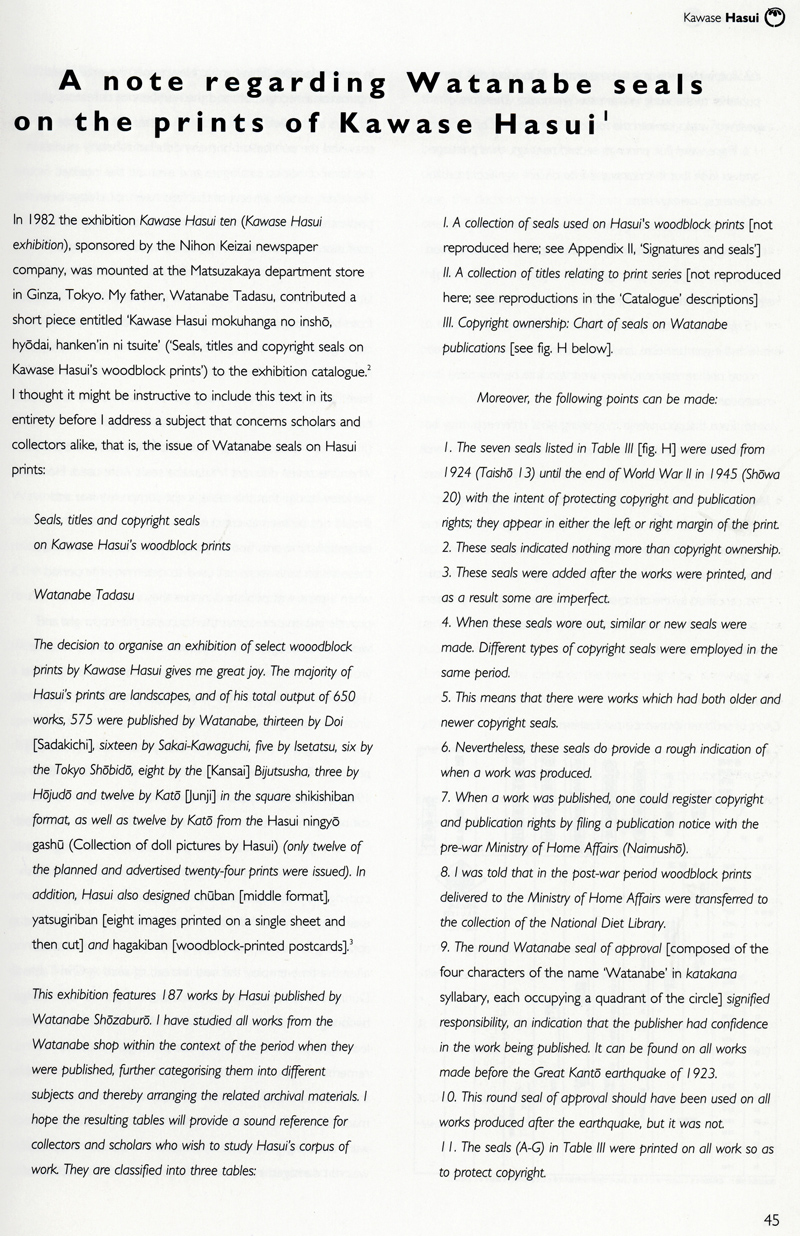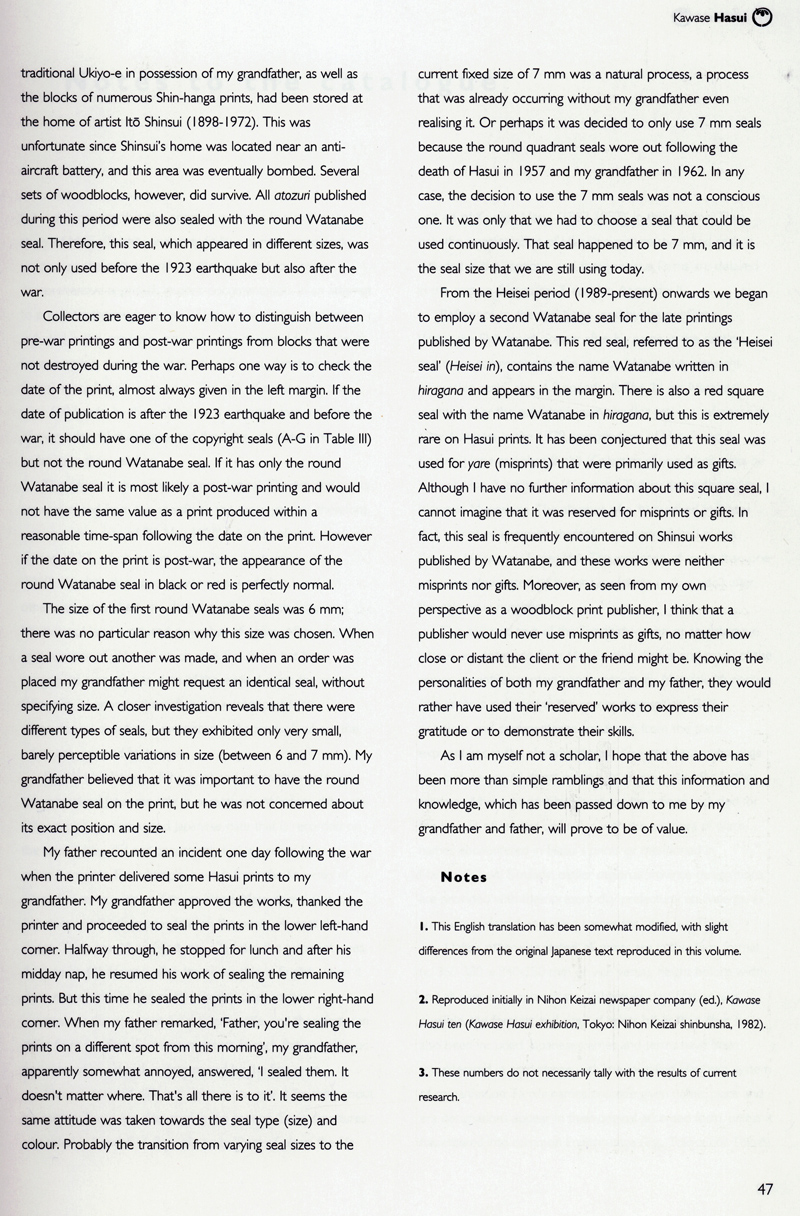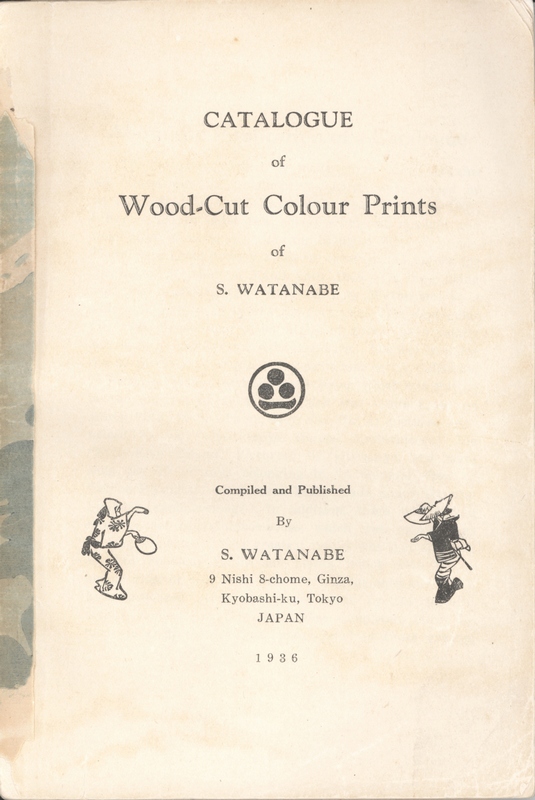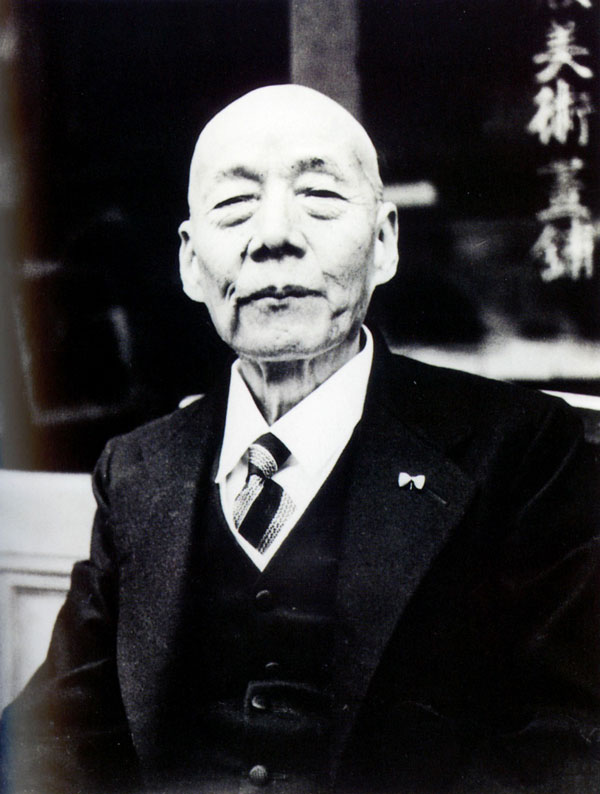 Watanabe Shōzaburō (undated photo) Watanabe Shōzaburō (undated photo) | Creator of the Shin Hanga Print MovementSource: Wikipedia website http://en.wikipedia.org/wiki/Watanabe_ShozaburoWatanabe Shōzaburō (渡辺庄三郎, 1885-1962) was a Japanese print publisher and the driving force behind the Japanese printmaking movement known as shin hanga ("new prints"). He started his career working for the export company of Kobayashi Bunshichi,which gave him an opportunity to learn about exporting art prints. In1908, Watanabe married Chiyo, a daughter of the woodblock carverChikamatsu. Watanabe published woodblock prints that combined traditionalJapanese techniques with elements of contemporary Western painting. Heemployed highly skilled carvers and printers, and commissioned artiststo design prints that combined traditional Japanese style with elementsof modern Western painting, such as perspective and shadows. Watanabecoined the term shin hangain 1915 to describe such prints. Charles W. Bartlett, Hashiguchi Goyō,Kawase Hasui (1883-1957), Yoshida Hiroshi (1876-1950), Kasamatsu Shiro (1898–1991), Torii Kotondo (1900-1976), Ohara Koson (Shoson) (1877-1945), Terashima Shimei, Itō Shinsui, Takahashi Shotei(Hiroaki) and Yamakawa Shuho are among the artists whose work hepublished. Watanabe exported most of his shin hanga prints to the United States and Europe due to a lack of Japanese interest. After the close of World War II his heirs continued the business, which still operates today. |
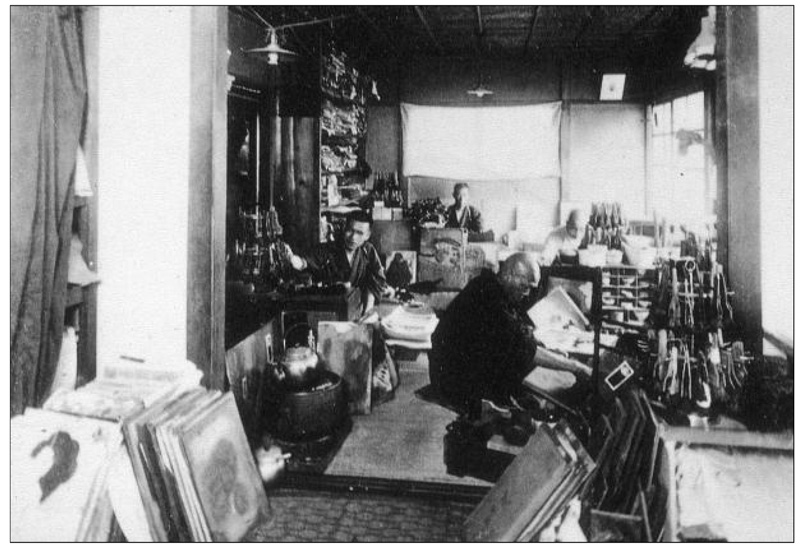
Watanabe Shozaburo Print Studio c. 1935
 | 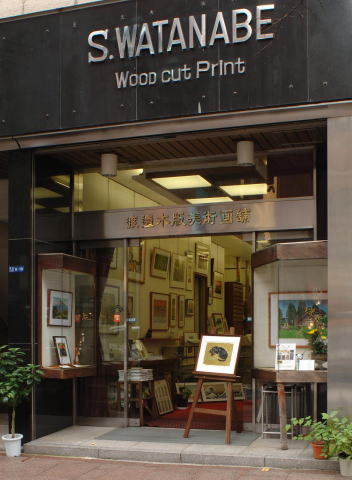 |
| Watanabe Shozaburo Print Shop in Kyobashi (present-day Chuo Ward, Ginza,Tokyo) Spring 1940 | S. Watanabe Color Print Co. 8-6-19 Ginza Chuo-Ku Tokyo The shop as it looks today |
A Testimonial to Watanabe Shōzaburō by Art Historian Jiro Harada
THE STUDIO: A Magazine of Fine and Applied Art
Volume 91, Number 397 April 15th 1926
Notes on Modern Wood-Block Printing in Japan by Jiro Harada
Watanabe Publisher Marks, Seals and Editions
Source: Kawase Hasui and His Contemporaries: The Shin Hanga (New Print) Movement in Landscape Art, Irwin J. Patcher, Everson Museum of Art, Syracuse, 1986, p. 35-37Print Numbering
In 1922, Watanabe decided to number prints by Hasui. He announced plans for a new series of 36 prints to be entitled Views of Japanese Scenery. The prints were to be serially numbered, each in an edition of 300. He advertised that only perfect ones would be chosen, after which the blocks would be destroyed and not reproduced. In 1923, as the series was being completed, the great Kanto earthquake and fire struck. The blocks were indeed destroyed, as were all unsold prints, Watanabe’s business establishment, Hasui’s home, sketches and notes, and much of Tokyo and the surrounding area. Thereafter, Watanabe did not promise that blocks would be destroyed, nor did he number Hasui’s later prints. Numbered prints were also produced in 1929-30 when Hasui worked briefly with the rival publishing house of Kawaguchi and Sakai.Most shin hanga prints are not numbered and considerable confusion exists as to the total number produced. Unfortunately, publishers have provided us with scant information on this subject. Often quoted by print dealers are the Toledo Museum catalogs of 1930 and 1936 where edition sizes were specified. These usually range from 100 to 300 impressions for prints by Hasui.
Hasui’s most popular print, Shiba Zojoji Temple in the Snow, was said to have been produced in an edition of 300. However, by the time of the 1930 Toledo Museum show, some 2000 prints were produced. Watanabe halted production at 3000 with the last of these being sold after the war.
Typical Margin Information
In the margin of each print are words to describe the scene and a Japanese date. The date refers to the first successful publication by the studio. Unlike the publisher’s seals, which we shall discuss next, these margin words and dates are an integral part of each print.
Watanabe Publishing Seals
Prior to 1924 Watanabe stamped his prints with a small circular seal which spelled his name. Starting some time in that year, it became necessary to claim copyright ownership and a series of cartouches was employed which stated “copyright owned by Watanabe Shozaburo,” sometimes adding “no copying without permission.” Since the publisher’s mark was added at a later time, it was occasionally omitted unintentionally. It is not unusual to find a print without any mark at all. When the seals were worn, new ones were carved of the same design or of a different design. The period of use of each of the designs thus overlapped. The below chart gives the approximate dates of use for these seals. After the war, copyright stamps were no longer necessary and the small circular seal was used once again.
Watanabe prints are further complicated by the use of a square seal mark of design H (see below chart.) This mark is not a regular seal and has been used for private publications, gift prints, artist proofs and for “unsuccessful prints".
Finally, one should note the use of the stamp of the printer Ono Gintaro. During the war the Watanabe family was absent and Ono was left in charge of the studio. Prints issued during those years bear his name.
Up to this time, print dealers and auction houses have made little distinction between Watanabe prints bearing earlier and later publisher’s marks. The tendency has been to treat all prints bearing publisher’s cartouches as “originals” and all (except, of course, those from before the earthquake) bearing the small circular seal as “restrikes.”
New prints published for the first time after the war all bore the circle seal of design A (see below chart) and were true originals. Also, the same master printers and artists worked together following the war to produce additional impressions of prints of earlier years. These were often equal and sometimes even superior in quality to those produced in the twenties and thirties even though they were stamped with the circle seal of design A.
In the last two decades or so, with the passing of the old artists and artisans, print quality has declined substantially. Hasui prints are still being produced today, but almost all are inferior to those made while the artist was alive. Recent prints can generally be distinguished from the older post-war prints not only through the quality of printing and the type of paper used, but also because the Watanabe publishing house is using a larger (7 mm) circular seal today of design I (see below chart) rather than the smaller one used right after the war of design A (6 mm).
| My Note: The "Heisei" rectangular seal is now beingapplied by Watanabe to all newly issued reprints. It should also be noted that the newprints still use the original woodblocks and many collectors consider the quality of the printing to be excellent, although the newly issued prints are far less desirable to collectors then prints issued during the artist's lifetime. |
Hasui prints and those of other Watanabe artists are stamped in ink with the artist’s name followed by his seal in red. Occasionally one finds prints signed in pencil in Western script. These signatures are not those of the artists but were added by Watanabe sales employees.
Watanabe Publishing Seals and Dating of Print Issuance
It is possible to approximately date prints issued by Watanabe through the following table.
B type - 版権所有渡邊庄三郎 [copyright reserved, Watanabe Shōzaburō]
C type - 版元渡邊版畫店 [publisher, Watanabe print store]
D type - 版権所有渡邊庄三郎 [copyright reserved, Watanabe Shōzaburō]
E type - 版権所有不許複製渡邊庄三郎 [copyright Reserved, reproduction not allowed without permission, Watanabe Shōzaburō]
H type - 渡辺木版美術画舗工作 [Watanabe fine art woodblock print store design]
J type - 渡邊版画店 東京市京橋區銀座西八ノ九 S. Watanabe NO. 9 Nishi 8-chome, Ginza Tokyo1 [Watanabe Print Shop, Tokyo, followed by address]
L type - 版元銀座渡邊格 [Watanabe Tadasu, publisher, Ginza)2
P-1 type - 摺 斧銀太郎 [printer Ono Gintarō]
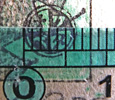 6mm 6mm(with ruler for reference) |  7mm (with ruler for reference) |
A note regarding Watanabe seals on the prints of Kawase Hasui
Stamp sometimes appearing on verso of Watanabe published prints

"Our Unique Woodblock Prints: Protecting a Lone Rampart,"
Watanabe Statement of July 18, 1930
Source: "The Publisher Watanabe Shozaburo and the Shin-hanga Movement: Its Beginnings until the 1930s," Abe Setsuko, article in The Hotei Encyclopedia of Japanese Woodblock Prints, Amy ReigleNewland, Hotei Publishing, 2005, p. 294-299
"Fine prints have more or less left the country... and Japan's unique art has in this way been practically lost... I am experimenting with new prints... Normally they involve twenty-four or twenty-five printings and if complicated then thirty-seven or thirty-eight printings..., so as not to destroy the artistic merit of the works. They are printed in limited editions of 200 prints. Without the three requisites of designer (artist), block-cutter and printer a print cannot be produced skillfully. The nature or sentiment of a print image must be portrayed in design terms which is why not just anyone can create the preparatory drawing for a print."
Watanabe Catalogue of Wood-Cut Colour Prints, 1936
Watanabe Introduction to 1951 Catalog of Prints
Source: ShinHanga.net website http://shinhanga.net/wat-cat-1951.htmIn 1907, with a view to inspiring the traditional Japanese artof wood-engraving with a new life, we started producing medium andsmall-sized new color-prints for foreign connoisseurs. At the same timewe compiled the "Mokuhan Ukiyoe Taika Gashû" (Book of Ukiyoe byCelebrated Artists) and the "Ukiyoe Hanga Kessaku-shû" (Collections ofMasterpieces of Ukiyoe) to encourage the general love for this uniqueart at home.
Flattering ourselves that from this experience we had been ableto grasp some of the spirit of the best old masters, we proceeded tostudy how really good modern color-prints could be created, with thehelp of several painters who were especially appreciative of ourproject. In this way, in 1915 we produced "Woman in the Bathroom" byGoyô Hashiguchi, in 1916 "Looking into the Mirror", an ambitiousattempt by Shinsui Itô, then a young painter of unusual talent, and in1918 and after landscape prints by Hasui Kawase. We were fortunateenough to enjoy a strong support of enthusiasts in Japan, and thefuture of new color-prints seemed highly promising.
Then a severe blow came in the form of the big Kantô earthquakeof September 1, 1923, which destroyed the printing blocks and othermaterials as well as many finished color-prints, crippling the growthof this new art so relentlessly before it was yet out of the cradle.However, since skilled painters, engravers and printers all survivedthe catastrophe, we immediately made a fresh start, while unstintedpatronage was accorded us by print-lovers both at home and abroad. Oureffort was not fruitless, for nine years later, in April 1932, we wereable to hold the first big exhibition after the earthquake at the artgallery of Shirokiya Department Store, Tokyo, where there was a jostlingcrowd every day.
This favourable development continued until the outbreak of theWorld War II. During the war, materials went short, the artistsdispersed and, worst of all, many of the printing blocks were reducedto ashes. However, that our shop itself escaped damage was our soleconsolation. We re-started the work soon after the end of the war, andwith the conviction that there is no boundary in the realm of art,hoped to contribute through color-prints to the promotion of goodwilland the reinforcement of cultural ties between nations. As this wasonly possible on a propitious footing, the first thing we did was tobring together our former staff who had been separated.
Now, after six years of post-war confusion, we have nearlycompleted our set-up to work on prints which will safely bearcomparison with the pre-war products. We are determined to put ourheart into every sheet of print, selecting materials all the morecarefully, and studying the technique of engraving under the close careof painters. Nothing is more sincerely solicited at this juncture thanyour continued patronage and encouragement.
The present catalog contains all of our productions after theearthquake of 1923. Even those now out of print have been included, asthe mere titles may serve as a record. Only the medium and small-sizedprints have been excluded. Color-prints of high grade are prized betterthan original paintings and photographs for their sumptuous beauty ofcolor, and are better suited as wedding gifts and lasting souvenirs.Their collection and connoisseurship is also an attractive hobby. Wehope that this catalog for 1951 will be found useful both by collectorsof prints and their dealers in making their selection.
December 1, 1951
SHÔZABURÔ WATANABE
Literature
Kawase Hasui: The CompleteWoodblock Prints, Kendall Brown, Amy Reigle Newland, Amsterdam, Hotei Publishing, KIT Publishers, 2003Kawase Hasui and His Contemporaries: The Shin Hanga (New Print) Movement in Landscape Art, Irwin J. Patcher, Everson Museum of Art, Syracuse, 1986
Printed to Perfection - Twentieth-century Japanese Prints from the Robert O. Muller Collection, Mervis, Newland, et. al., Hotei Publishing, 2004
Shin-Hanga - New Prints in Modern Japan, Kendall Brown, Hollis Goodall-Cristante, Los Angeles County Museum of Art, 1996
Websites
last revision:
